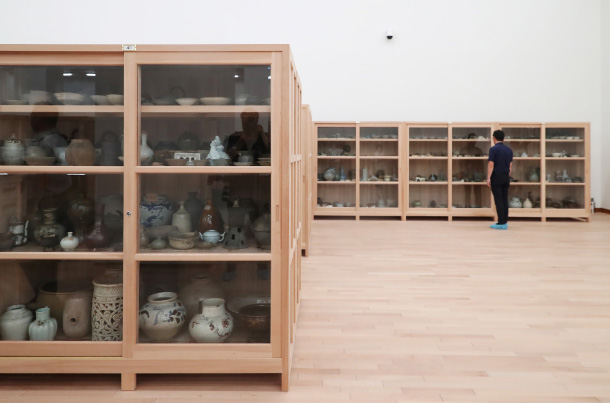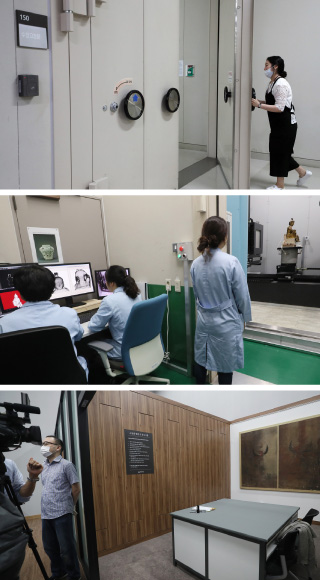National Museum’s hidden side : Stored treasures can be viewed by anyone


From top: The National Museum of Korea in central Seoul revealed its storage area for the first time in 15 years on Tuesday; a museum official opens the vault door to the storage area; museum researchers conduct a CT scan on a statue of Buddha; a renovated Study Room can be used by anyone to get a closer look at national treasures. [JOONGANG ILBO, YONHAP]
On Tuesday morning, a group of local reporters were given shoe covers prior to going inside the museum’s storage area - to make sure they didn’t bring dirt and dust inside. When everyone was ready, a museum official opened a large vault-like door, ushering the reporters into a bright room lined with wood framed glass cabinets. Inside were displays of hundreds of ceramics, some inside boxes, some wrapped and some simply sitting bare on the shelves. The reporters were inside Storage No. 3, home to a good part of the museum’s ceramics collection.
The museum has 21 storage rooms housing about 200,000 items. Different types of items are stored in different rooms, according to Park Jin-woo, head manager of the Relics Management Department of the museum, to make sure they are kept at exactly the right temperature and with the right humidity.
“Sensitive relics, like paper and metals, have to be really closely watched as the wrong level humidity can lead them to deteriorate,” he said. According to Park, about 80 percent of the museum’s storage is full, and the museum is planning to expand the space by adding an additional floor to four of the rooms.
“When we constructed the storage area, we designed the ceilings to be high to make sure we could install a second floor if necessary,” he added.
Although the public can’t access the storage area, they can get a closer look at items not on permanent display in the museum’s Study Room, which is located next to the storage area. Early this year, the museum renovated the Study Room to accommodate more people.
“Before the renovation, the study room was so small that only scholars and researchers accessed it,” said Cheon Ju-yeon, a researcher at the museum. “But since the reopening, more members of the public have been coming in and we’ve seen a 100 percent increase in the number of visitors to this section this year.”
Surprisingly, any member of the public can ask to see items not on permanent display in the Study Room.

Bae Ki-dong
Reporters were also taken to the Conservation Science Division, “which is similar to a hospital,” said Yoo Hye-sun, head manager of the division. “We just purchased a CT machine last year and began using it this year to do what we call medical check-ups for all the relics in the museum.”
Tuesday marked the one-year anniversary of director general Bae Ki-dong’s appointment. Bae told reporters the museum has been expanding its collection as well as adopting new technologies to make sure the valuable relics are maintained, and allowing the public better access to the museum.
“Korea is one of the most digitalized countries, but we were quite slow in adopting technologies, like a CT scanner,” Bae said. “We’ll make sure we don’t fall behind, but pave a future for the museum by completing the digitization of our content and adopting various new technologies.”
BY YIM SEUNG-HYE [sharon@joongang.co.kr]










with the Korea JoongAng Daily
To write comments, please log in to one of the accounts.
Standards Board Policy (0/250자)